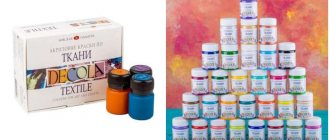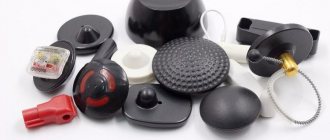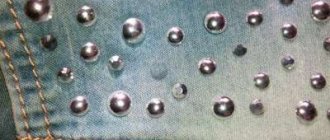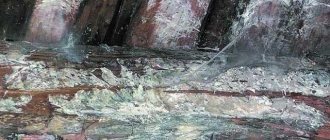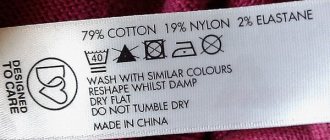What types of fabrics can be dyed?
Before you start painting, you need to understand what materials are suitable for it in principle. This list includes:
- Cotton, linen, silk, wool, wool mixture - materials are ideal for dyeing, even if you are new to this business. The fabric absorbs paint very quickly and, with proper care, practically does not fade.
- Nylon - powder paint adheres well to it. Dyeing fabric is also easy - nylon quickly absorbs the dye.
- PVC - elements of work uniforms, clothing covers, bags and backpacks are most often made from such fabrics. Acrylic dyes are best suited for coloring them.
Sweaters, jumpers and other knitted items should not be dyed at home: the pigment will not be able to dye the fibers evenly.
Why is this procedure needed?
Any thing sooner or later loses its brightness and expressiveness. Housewives are often lazy and do not follow the rules for caring for clothes written on the labels. As a result, the item, before it has time to wear out, becomes dull and lifeless. Store-bought dyes or natural products can bring old, washed-out items back to life.
Fabric dyes are a way to highlight your individuality. Creative people see them as a great opportunity for experimentation. By showing your imagination, you can turn an ordinary white T-shirt into a masterpiece. Surely no one will have such clothes. Dyes are an essential attribute in the work of a home seamstress.
How can you dye fabric? Learning to understand dyes
Most often, if you ask this question to a sales assistant at a craft supply store, he will recommend acrylic or powder paint. If you ask experienced needlewomen, they will advise using folk remedies. Below we will look at each option in detail so that you can choose the one that suits you.
Acrylic paint
Ideal for creating designs on clothes. Even if you don’t know how to draw, you can use a stencil - this way the drawing turns out clear, without spots, streaks and dirt. Since acrylic dries quickly, you need to ensure that the jar is open for no longer than an hour or use a tube with a tight-fitting lid. You can also lay out the paint on the palette in advance.
If the acrylic has already begun to dry, do not dilute it with water, otherwise the design will crack or peel off after the first wash.
Powder paint (aniline)
Suitable for dyeing natural fabrics: cotton fabric (cotton for short), cotton, wool and silk, but for synthetics it is better to choose something else. Typically, aniline dyes are diluted with water in a ratio of 1 to 30, the clothes are immersed in the prepared solution and begin to “cook” at a temperature of 95 degrees. Upon completion of the process, you need to fix the pigment with salt, the amount of which varies from 2 to 5 spoons, depending on the size of the product and the amount of water.
If you are dyeing wool, add a little more vinegar to the salt, and if you are dyeing cotton, add a little soda. This will allow the dye to be fixed in the texture of the product.
Do not be alarmed if after the first washes the fabric fades - this is normal, since initially it absorbs more dye than necessary.
Stamp ink
Used to leave a label on clothing or mark hotel textiles.
The composition of stamp inks varies, as do the subtleties of use:
- Alcohol based - the fastest drying. After dyeing, the product can be washed many times, even with bleach, without fear that the applied pattern will fade.
- Glycerin - dries very slowly, but is highly resistant to water and shedding. The palette is limited to shades of black, brown and blue.
- Colorless - used for hidden marking of branded textiles, visible only under ultraviolet light.
Reflective paints
Plastisol-based tints are often used by manufacturers of sportswear and footwear to create patterns that will be visible in the dark due to the cumulative effect. During the day, the pattern is practically invisible, but at night or in a club under ultraviolet light it acquires a soft pinkish, yellow, or greenish glow.
There are also luminescent paints, which contain a safe luminous phosphor powder. If it is necessary to reduce the intensity of the glow, the composition can be diluted with colorless clothing varnish. Some paints have fine glitter added. Most often used for painting on cotton clothing: T-shirts, jackets and denim trousers.
Aerosol paints
The aerosol is convenient to use when you need to apply a design through a stencil. The tissue at the site of application becomes stronger and loses elasticity. Best suited for applying patterns to clothes made of leather, faux leather or denim.
Natural dyes
Most spices, vegetables, fruits and berries can be used as a natural dye. You will definitely find something suitable in your kitchen. This is a rather labor-intensive process. It is most often used to dye things that will no longer be washed either by hand or in a washing machine, since dyes behave unpredictably.
Let's look at what products you need to use to get bright shades.
- Red color - juice of beets, blueberries, pomegranates and black currants give colors from dusty pink to deep red, depending on the concentration of the solution.
- The blue color, and therefore blue and purple, can be obtained by using the juice of red cabbage or blackberries.
- Yellow color - juice and skins from bright citrus fruits are suitable.
- Green color is pleasant to the eye; pure green color is quite difficult to obtain from natural products. Some people use elderberries, juniper or spinach. Painting fabric with green gives a more stable and bright result, but you need to work with gloves.
- Orange/amber color - can be obtained from a decoction of onion skins. The same thing that our grandmothers used to color eggs for Easter. And sea buckthorn berries are also suitable.
- Beige and creamy can be obtained from strong coffee or tea.
What is professional dry cleaning?
Professional dyeing of clothes at a dry cleaner allows you to refresh and return the original color of expensive items. Many products are almost new in appearance, but their faded or discolored appearance is alarming. It is always a pity to part with exclusive and very expensive things that have become pale and unattractive.
Dyeing fabrics with natural dyes: step-by-step instructions
How to dye fabric if you only have the contents of the refrigerator and groceries?
The following step-by-step instructions will help you avoid mistakes:
- Grind the coloring ingredient with a knife or grater, if necessary.
- Place in a saucepan and add water in a ratio of 1 to 2.
- Bring to a boil and leave for an hour. For a more saturated pigment, you can leave the liquid overnight.
- Strain the water thoroughly: make sure that there are no small pieces left in it - otherwise they will leave stains on your clothes.
- Prepare a paint fixative: if you are using berry or fruit juice, add half a cup of salt to 2 liters of water, bring to a boil, put a cloth there and boil for an hour. The proportions can be increased according to the size of the item being painted. If you paint with vegetables, spices or herbs, you need a vinegar solution. To prepare it, add four equal portions of water to one part of vinegar, put a cloth there and heat over low heat for an hour.
- After the time has passed, remove the item from the fixative solution and rinse in ice water.
- Dip the fabric into the dye and leave it for a while - the longer it stays there, the richer its final color will be.
When the product dries, the fabric will turn pale. Take this into account and paint the product longer if necessary.
The most common modern dry cleaning services:
- Dyeing jeans at a dry cleaner. Today it is the most popular service in this industry. The fact is that trousers and jeans themselves last quite a long time, but their color fades very quickly in the sun. After professional treatment they will look like new. By the way, in the future, they will not fade during washing, so you will not have to worry about damage to other things.
- Painting jackets. When it comes to jackets fading or fading, many people throw away the items, thinking that in such a situation there is no other way than to purchase a new item. In fact, all this is fixable, just rehabilitation is done by painting textiles and leather separately.
- Professional painting of dresses. Today, in order to surround yourself with truly beautiful things with rich colors, it is enough to follow fashion trends; you do not have to spend huge sums of money on buying branded products, you just need to have your dress dyed a different color at the dry cleaner.
We paint clothes with ready-made paint - general recommendations
Do not deviate from the manufacturer's instructions! This is the first and main rule that must be followed in order to get a guaranteed good result. Violating the recommendations on the packaging can lead to you only wasting your time and, instead of giving the item a “second life,” you will hopelessly ruin it.
Before starting work, the fabric must be prepared. Here are some tips to help you achieve the desired effect from your paint job.
- White fabric can be dyed almost any color. But colored things, especially black ones, will have to be bleached first.
- How and with what to dye dark fabric if it is impossible to bleach it? Choose a pigment that will completely cover the color of the item. A universal solution would be black or dark blue.
- Before dyeing an item, be sure to wash it for a uniform result.
- Decorative elements (beads, rhinestones, stripes, etc.) must be threaded in advance, otherwise they will not allow the color to lie evenly on the material.
- To accurately calculate the required amount of paint, the fabric must be weighed dry. The exact proportions are usually indicated in the instructions for the pigment.
For the fabric dyeing process, it is better to use soft filtered, boiled or distilled water. If this is not the case, you can use tap water after softening it with soda.
Folk remedies
Natural paints include mint (for green), beets (for red and pink), activated carbon and other products containing a large amount of pigment.
Machine painting
But since in modern times there is a large selection of dyes for clothes, almost no one uses such recipes. In the past, many women would boil jeans or outerwear for several hours to give the item a fresh look.
You may be interested in this: Simple patterns for sewing jeans yourself
Caring for clothes after dyeing
Dyeing old fabric at home is just the first step. It is necessary to properly care for a painted item - this is somewhat more difficult than simply washing it in a washing machine.
The following recommendations will help you enjoy the results of your own labor longer:
- Do not dry the item in direct sunlight, otherwise the color will fade quite quickly and unevenly.
- It is advisable to wash dyed clothes separately from other laundry.
- If you need to wash clothes that have been painted with acrylic paint, wash them by hand.
- It is important to choose the right detergent: for dyed types of fabrics, a powder marked “for color” and a “color preservation” conditioner are best suited.
When finished washing, rinse the item in cool water and add a little vinegar. This will fix the color within the fabric fibers.
Helpful Tips and Tricks
- Before painting, weigh the product - this will allow you to determine the exact amount of dye.
- Dishes that have been stained with chemicals must not be used for cooking!
- For silk fabrics: when rinsing, add 1 tbsp to the water. vinegar.
- For wool fabrics: dissolve the dye in hot water.
- For denim and linen clothes: first add a pinch of ash salt to the dye and only then dissolve it in water.
- If the cellulose fabric is stained unevenly, soak it in hot water and laundry detergent. This measure will help even out the color.
- If the item is going to be altered, then it needs to be ripped apart at the seams before dyeing.
- You can put a wooden plank at the bottom of the container to prevent the clothes from burning.
- Do not dry wool items on hangers. They can stretch out under their own weight. Just lay them out on a flat surface.
Don't be afraid to experiment! May your old clothes be reborn and serve you for some time to come!
FAQ on dyeing non-standard fabrics
How to dye faded fabric if the above methods are not suitable? Below we will talk about how to dye fabric if you are faced with a non-standard task.
- How to paint a tarpaulin ? This fabric can be repainted with construction colors or rubber paint. In both the first and second cases, the coating will take a long time to dry.
- How to hide a stain on clothes? If the problem is a stain, try ironing the item from the inside out through a clean cloth. There is a possibility that it will work. If this method does not help, use a fabric marker and cover the stain with an acrylic design or transfer applique.
- How to cover burlap? – This fabric can be painted using a spray or water-based paint, applying it with a brush using percussive movements. Do not paint over the burlap completely, otherwise it will become too tough.
- How to paint a raincoat fabric? — Nylon dye is suitable for raincoat fabric.
- How to dye rubberized fabric ? – To color rubberized fabric, mix rubber glue and construction color in equal proportions. Apply the resulting composition to the product with a brush and leave until completely dry.
- How to repaint synthetic winterizer? – The desired color of padding polyester can be easily achieved by using auto enamel spray.
Pigment selection
What natural dye can be used to dye fabric:
- tea;
- cocoa - for a chocolate shade;
- rich coffee will turn black;
- onion peel;
- wolf berries - red;
- blueberries, blackberries for a juicy purple color;
- cranberry;
- walnut peel - beige or sandy;
- spinach, sorrel, elderberry leaves will color the canvas green;
- beets for the pink to burgundy range;
- cabbage;
- turmeric, celandine – orange, red;
- carrot juice, sea buckthorn.
On a note
Tip: to consolidate the results of using natural pigments, use vinegar essence and salt.
How you can dye things: stores sell a special fabric dye in the form of a liquid, paste, spray or powder. The main advantage of such a tool is that there are clear instructions, it’s difficult to make a mistake. Some people use food coloring.
Is it possible to dye fabric with hair dye: yes, but the color may not be very saturated. Especially if you use dark shades on heavily faded material. If you are not careful, the material will become stained.
Natural fibers are painted with acrylic paints. It is not possible to fill artificial or synthetic organza with pigment using acrylic paints.
White fabric dye comes in acrylic, aniline, or spray form. It is applied to pre-bleached fabric to give a pure shade.
How to choose a color?
The initial shade of clothing is the basis for creative experiments. In most cases it is not possible to choose any color. Choose the one that will be darker. You can't turn a gray cardigan yellow. Moreover, a white item will not turn black, since after a single procedure the gray color will be achieved. You are limited in your choice of color, but you can implement a decent option if you wish.
By choosing a deep shade of the main color, you will achieve the best transformation of your clothes. This approach guarantees good quality and will give clothes a second wind.
Don't worry if the wet item looks too dark. After drying, the clothes will become a couple of shades lighter, and you will be able to evaluate the result.
For fear of making a mistake, carry out a test stain using a small piece of material. If the procedure went well, dye the clothes completely.
This is interesting: How to wash linen items: important rules, methods
Brushed firing and metallic patina (dry brush)
I have another board with firing and brushing. By combining firing, brushing and dry brushing, you can achieve different visual effects, lightening the texture of the wood or, conversely, darkening it. And I want to show the metallic patina in this example. I paint the board deep black, using velvet black from the Acrylic De Luxe line.
Metallic paints look best and shimmer on dark surfaces. Next, I take Decolor metallic paints and work using the dry brush technique: I put paint on a brush (it is better to use flat, coarse bristles), wipe off the excess on a napkin and begin painting in the direction of the wood grain.
It is important not to overdo it and stop in time. The result is an elegant metallized coating that emphasizes the wood grain.
